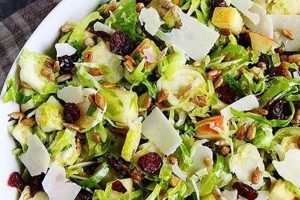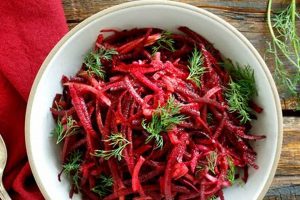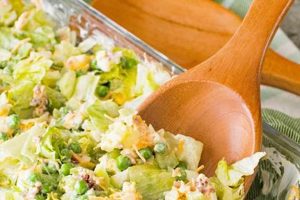A structured set of instructions for preparing the classic American dish typically composed of apples, celery, grapes, walnuts, and mayonnaise, often served on a bed of lettuce, represents a culinary guide to creating this iconic salad. Variations may include different types of nuts, dried fruits, or poultry.
Providing a clear methodology for consistent results, a formalized preparation method ensures that the balance of sweet, tart, and savory flavors remains consistent. Its historical significance lies in its origin at the Waldorf-Astoria Hotel in New York City in the late 19th century, marking its place as a celebrated element of American culinary history. This enduring popularity speaks to the dish’s refreshing simplicity and adaptability to various palates.
Further exploration will delve into ingredient selection, preparation techniques, variations, and serving suggestions to enhance the enjoyment and understanding of this iconic dish.
Tips for Waldorf Salad Preparation
Optimizing ingredient selection and preparation techniques elevates this classic dish. Attention to detail ensures a balanced and flavorful experience.
Tip 1: Apple Selection: Opt for crisp, tart apples such as Granny Smith or Honeycrisp. Their texture and flavor profile complement the other ingredients. Avoid overly sweet or mealy apples.
Tip 2: Celery Preparation: Use crisp, inner celery stalks for optimal texture. Remove any fibrous strings for a more refined salad.
Tip 3: Grape Choices: Red or green seedless grapes offer a pleasant sweetness and visual appeal. Consider using a combination for added color and flavor complexity.
Tip 4: Nut Enhancement: Toasting walnuts enhances their flavor and provides a satisfying crunch. Alternatively, pecans or almonds can be substituted for textural and flavor variations.
Tip 5: Mayonnaise Considerations: High-quality mayonnaise contributes significantly to the overall flavor profile. Consider using homemade mayonnaise or a premium brand for superior results.
Tip 6: Freshness is Key: Prepare the salad as close to serving time as possible to prevent the apples and celery from browning and maintain optimal texture.
Tip 7: Proportions Matter: Maintain a balance of ingredients. Too much mayonnaise can overwhelm the other flavors, while insufficient amounts can result in a dry salad. Taste and adjust as needed.
By following these guidelines, one achieves a Waldorf salad that showcases the harmonious blend of flavors and textures characteristic of this classic dish.
These techniques contribute to a consistently delightful culinary experience, ensuring the Waldorf salad remains a timeless favorite.
1. Ingredients
Ingredients form the foundation of any recipe for Waldorf salad, directly impacting the final dish’s flavor, texture, and overall quality. The careful selection and preparation of each component are essential for achieving the desired balance of sweet, tart, savory, and crunchy elements that define this classic salad. A Waldorf salad’s core ingredients typically include apples, celery, grapes, walnuts, and mayonnaise. Deviations from this basic formula, through ingredient substitutions or additions, create variations impacting the sensory experience.
For example, using tart Granny Smith apples contributes a crisp texture and tartness that balances the sweetness of grapes and the richness of mayonnaise. Substituting red grapes for green alters the salad’s color and introduces subtle flavor nuances. The addition of toasted walnuts provides a satisfying crunch and nutty flavor, while the use of a high-quality mayonnaise enhances the overall creaminess and richness. These examples demonstrate the direct causal relationship between ingredient choices and the final product’s characteristics. Understanding these relationships allows for informed decisions when adapting the recipe to individual preferences or dietary needs.
The practical significance of understanding the role of ingredients in a Waldorf salad recipe lies in the ability to create a dish that consistently delivers the expected flavor and textural profile. Careful attention to ingredient quality, preparation methods, and proportions allows for control over the final outcome, ensuring a successful and enjoyable culinary experience. This knowledge empowers individuals to adapt the recipe confidently, creating personalized variations while retaining the essence of this classic dish. Challenges may arise from ingredient availability or seasonal variations; however, a thorough understanding of each component’s contribution allows for informed substitutions without compromising the fundamental balance of flavors and textures.
2. Proportions
Proportions in a Waldorf salad recipe govern the balance of flavors and textures, impacting the overall culinary experience. The ratio of ingredients determines whether the salad leans towards sweet, tart, creamy, or crunchy. Understanding these proportions allows for consistent recreation of the desired flavor profile and adaptation to individual preferences.
- Apple-to-Celery Ratio:
This ratio influences the salad’s sweetness and crunch. A higher apple proportion results in a sweeter, less vegetal flavor, whereas more celery emphasizes the savory notes and adds a pronounced crunch. A classic Waldorf salad often features a roughly equal proportion of these two ingredients, creating a balance between sweet and savory.
- Mayonnaise Quantity:
Mayonnaise contributes creaminess and richness. Too little results in a dry salad lacking cohesion, while an excessive amount can overpower the other flavors. The ideal amount binds the ingredients together without masking the individual flavors of the apples, celery, and grapes.
- Nut-to-Fruit Ratio:
Nuts provide texture and flavor contrast. The proportion of nuts to fruits determines the salad’s overall crunch and the intensity of the nutty flavor. A higher nut ratio delivers more crunch and a pronounced nutty flavor, while a lower ratio allows the fruit flavors to take center stage.
- Grape Inclusion:
Grapes contribute sweetness and juiciness. Their proportion relative to other ingredients affects the overall sweetness and moisture content of the salad. Adjusting the grape quantity allows for customization based on preference for sweetness and the desired textural balance.
Mastering these proportions allows for consistent preparation of a well-balanced Waldorf salad. Adapting these ratios provides flexibility for personalized variations, accommodating dietary restrictions or individual preferences while preserving the essence of this classic dish. Consideration of these proportional relationships ultimately elevates the culinary experience, demonstrating the crucial role of balance in achieving a harmonious blend of flavors and textures.
3. Preparation Method
Preparation method significantly influences the final quality and sensory experience of a Waldorf salad. Specific techniques impact ingredient freshness, prevent oxidation, and ensure optimal texture and flavor development. The order of operations dictates the overall outcome, highlighting the cause-and-effect relationship between preparation and the resulting dish.
For instance, dicing apples and celery shortly before combining them with other ingredients prevents enzymatic browning, preserving their fresh appearance and flavor. Tossing these ingredients with a small amount of lemon juice further inhibits oxidation. Adding the mayonnaise dressing just before serving maintains the salad’s crispness, preventing the ingredients from becoming soggy. Furthermore, toasting the walnuts enhances their flavor and provides textural contrast. These examples illustrate how specific preparation techniques directly impact the final product’s quality attributes.
Understanding the nuances of Waldorf salad preparation allows for consistent results and maximization of flavor and texture. While variations exist, adherence to fundamental principles ensures a balanced and enjoyable culinary experience. Challenges, such as ingredient seasonality or availability, can influence the preparation process. However, a solid grasp of these techniques allows for informed adaptations while preserving the essence of this classic dish. This knowledge translates to greater control over the final product, empowering culinary exploration and consistent delivery of a high-quality Waldorf salad.
4. Variations
Variations within the established framework of a Waldorf salad recipe demonstrate the dish’s adaptability and enduring appeal. These modifications, ranging from ingredient substitutions to additions, allow for personalized interpretations while retaining the fundamental characteristics of this classic salad. Exploring these variations provides insights into the interplay of flavors and textures and the potential for culinary creativity within a defined structure.
- Fruit Modifications
Substituting or adding different fruits alters the salad’s flavor profile and sweetness. Dried cranberries or chopped dates introduce concentrated sweetness and chewy textures. Seasonal fruits, such as berries or peaches, offer fresh, vibrant flavors reflecting seasonal availability. These modifications provide opportunities to explore complementary flavor combinations and tailor the salad to individual preferences.
- Nut Alternatives
Substituting walnuts with other nuts transforms the salad’s texture and flavor. Pecans offer a buttery richness, while almonds provide a delicate crunch and subtle sweetness. Toasted hazelnuts contribute an earthy depth, and cashews offer a creamy texture and mild flavor. These variations impact the overall sensory experience, allowing for customization based on desired flavor profiles and textural preferences.
- Protein Additions
Incorporating protein transforms the salad into a more substantial meal. Grilled chicken or shrimp adds savory depth and enhances the nutritional value. Crispy bacon provides a smoky, salty counterpoint to the sweetness of the fruits. These additions cater to diverse dietary needs and expand the Waldorf salad’s versatility beyond a side dish or appetizer.
- Dressing Enhancements
Variations in the dressing introduce new flavors and textures. Adding a touch of honey or maple syrup enhances sweetness and provides a subtle floral note. Incorporating yogurt or sour cream alongside mayonnaise lightens the dressing and adds a tangy dimension. A squeeze of lemon juice brightens the flavors and enhances the freshness. These modifications allow for exploration of different flavor profiles and textural complexities.
These variations, while diverse, retain the core essence of a Waldorf salad. They highlight the dish’s adaptability and its capacity to accommodate individual preferences and dietary needs. The ability to modify ingredients and preparation methods allows for continuous exploration and personalized interpretations, ensuring the Waldorf salad remains a versatile and enduring culinary classic.
5. Presentation
Presentation elevates the Waldorf salad experience, transforming a simple combination of ingredients into a visually appealing and appetizing dish. Thoughtful presentation enhances the perceived value and enjoyment, demonstrating that visual appeal plays a crucial role in the overall culinary experience, alongside flavor and texture. The manner in which the salad is served influences perceptions of freshness, quality, and attention to detail.
- Plating Techniques
Plating techniques directly impact visual appeal. A classic approach involves arranging the salad on a bed of crisp lettuce, providing a contrasting green backdrop that highlights the salad’s colors and textures. Alternatively, using a hollowed-out apple or other fruit as a serving vessel adds an element of whimsy and reinforces the fresh, natural ingredients. The choice of serving dish, whether a simple bowl or a more elaborate platter, further contributes to the overall presentation.
- Garnishing
Garnishes add visual interest and enhance flavor. A sprinkle of chopped walnuts or a few strategically placed grapes elevates the presentation. Fresh herbs, such as chopped parsley or mint, provide a pop of color and a complementary aromatic element. These small details demonstrate attention to detail and elevate the perceived quality of the dish.
- Color and Contrast
The inherent colors of the Waldorf salad ingredientsthe vibrant green of celery, the red or green of grapes, the creamy white of mayonnaisealready offer visual appeal. However, thoughtful arrangement and the addition of garnishes can amplify this inherent contrast, creating a visually dynamic and appetizing presentation. Consider the placement of ingredients to maximize color variation and visual interest.
- Portion Size
Portion size influences perception and satisfaction. A properly portioned salad ensures that the flavors and textures remain balanced and prevents the dish from appearing overwhelming. Whether served as an appetizer, side dish, or main course, the portion size should align with the context of the meal and the expectations of the diner.
These facets of presentation contribute significantly to the overall enjoyment of a Waldorf salad. While the recipe itself dictates the flavor profile, the presentation elevates the dining experience, transforming a simple dish into a visually appealing and memorable culinary creation. Consideration of these elements demonstrates a commitment to detail and enhances the perceived value, showcasing the important role of visual appeal in culinary arts.
Frequently Asked Questions
This section addresses common inquiries regarding Waldorf salad preparation and variations, offering practical guidance for achieving optimal results and clarifying potential points of confusion.
Question 1: How can browning of apples and celery be prevented?
Dicing these ingredients immediately before combining them with other components and lightly coating them with lemon juice inhibits enzymatic browning, preserving freshness.
Question 2: What are suitable alternatives to walnuts?
Pecans, almonds, hazelnuts, or cashews offer varying textures and flavors while retaining the desired crunch. Selection depends on individual preferences and desired flavor profiles.
Question 3: Can Waldorf salad be prepared in advance?
While best served fresh, advance preparation is possible. Store diced apples and celery separately, coated with lemon juice, and combine with other ingredients shortly before serving to maintain optimal texture and prevent sogginess.
Question 4: What are appropriate dressings besides mayonnaise?
Greek yogurt, sour cream, or a combination thereof, can be used alongside or in place of mayonnaise, offering a lighter, tangier alternative. A vinaigrette-based dressing, while less traditional, offers a different flavor profile.
Question 5: How can the sweetness of the salad be adjusted?
Adjusting the quantity of grapes or incorporating alternative fruits like dried cranberries or dates modifies the sweetness level. A touch of honey or maple syrup in the dressing also enhances sweetness.
Question 6: How can Waldorf salad be made more substantial as a main course?
Adding grilled chicken, shrimp, or crispy bacon elevates the salad into a more filling meal, providing protein and enhancing savory notes.
Understanding these aspects of Waldorf salad preparation ensures consistent, high-quality results and allows for adaptation based on individual preferences and dietary needs.
The following section explores additional tips and variations for enhancing the Waldorf salad experience.
Conclusion
Exploration of the Waldorf salad recipe reveals a dish characterized by simplicity, adaptability, and enduring appeal. From ingredient selection and preparation methods to variations and presentation, each aspect contributes to the final culinary experience. Understanding the interplay of flavors and textures, the importance of proportions, and the impact of preparation techniques empowers culinary creativity within a defined framework. The historical context and enduring popularity underscore the dish’s significance in American culinary history.
The Waldorf salad exemplifies the potential for culinary evolution within established traditions. Continued exploration of variations and adaptations ensures its relevance in contemporary cuisine. Careful consideration of ingredients, proportions, and presentation elevates this seemingly simple dish, transforming it into a timeless classic capable of satisfying diverse palates and culinary preferences.






